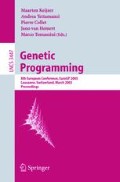Abstract
This paper explores distance measures based on genetic operators for genetic programming using tree structures. The consistency between genetic operators and distance measures is a crucial point for analytical measures of problem difficulty, such as fitness distance correlation, and for measures of population diversity, such as entropy or variance. The contribution of this paper is the exploration of possible definitions and approximations of operator-based edit distance measures. In particular, we focus on the subtree crossover operator. An empirical study is presented to illustrate the features of an operator-based distance. This paper makes progress toward improved algorithmic analysis by using appropriate measures of distance and similarity.
Access this chapter
Tax calculation will be finalised at checkout
Purchases are for personal use only
Preview
Unable to display preview. Download preview PDF.
References
Koza, J.R.: Genetic Programming: On the Programming of Computers by Means of Natural Selection. MIT Press, Cambridge (1992)
Jones, T., Forrest, S.: Fitness distance correlation as a measure of problem difficulty for genetic algorithms. In: Eshelman, L. (ed.) Proceedings of the Sixth International Conference on Genetic Algorithms, pp. 184–192. Morgan Kaufmann, San Francisco (1995)
Tomassini, M., Vanneschi, L., Collard, P., Clergue, M.: A study of fitness distance correlation as a difficulty measure in genetic programming. Evolutionary Computation (in press)
Vanneschi, L., Tomassini, M., Collard, P., Clergue, M.: Fitness distance correlation in structural mutation genetic programming. In: Ryan, C., Soule, T., Keijzer, M., Tsang, E.P.K., Poli, R., Costa, E. (eds.) EuroGP 2003. LNCS, vol. 2610, pp. 459–468. Springer, Heidelberg (2003)
Vanneschi, L.: Theory and Practice for Efficient Genetic Programming. Ph.D. thesis, University of Lausanne, Switzerland (2004)
Gustafson, S., Ekárt, A., Burke, E.K., Kendall, G.: Problem difficulty and code growth in genetic programming. Genetic Programming and Evolvable Hardware 5(3), 271–290 (2004)
Gustafson, S.: An Analysis of Diversity in Genetic Programming. PhD thesis, School of Computer Science and Information Technology, University of Nottingham, Nottingham, England (February 2004)
Burke, E.K., Gustafson, S., Kendall, G.: Diversity in genetic programming: An analysis of measures and correlation with fitness. IEEE Transactions on Evolutionary Computation 8(1), 47–62 (2004)
McPhee, N.F., Hopper, N.J.: Analysis of genetic diversity through population history. In: Banzhaf, W., et al. (eds.) Proceedings of the Genetic and Evolutionary Computation Conference, FL, USA, pp. 1112–1120. Morgan Kaufmann, San Francisco (1999)
Wineberg, M., Oppacher, F.: Distance between populations. In: Cantú-Paz, E., Foster, J.A., Deb, K., Davis, L., Roy, R., O’Reilly, U.-M., Beyer, H.-G., Kendall, G., Wilson, S.W., Harman, M., Wegener, J., Dasgupta, D., Potter, M.A., Schultz, A., Dowsland, K.A., Jonoska, N., Miller, J., Standish, R.K. (eds.) GECCO 2003. LNCS, vol. 2724, pp. 1481–1492. Springer, Heidelberg (2003)
Poli, R., McPhee, N.F.: General schema theory for genetic programming with subtree-swapping crossover: Part i. Evolutionary Computation 11(1), 53–66 (2003)
Daida, J.M., Li, H., Tang, R., Hilss, A.M.: What makes a problem GP-hard? validating a hypothesis of structural causes. In: Cantú-Paz, E., Foster, J.A., Deb, K., Davis, L., Roy, R., O’Reilly, U.-M., Beyer, H.-G., Kendall, G., Wilson, S.W., Harman, M., Wegener, J., Dasgupta, D., Potter, M.A., Schultz, A., Dowsland, K.A., Jonoska, N., Miller, J., Standish, R.K. (eds.) GECCO 2003. LNCS, vol. 2724, pp. 1665–1677. Springer, Heidelberg (2003)
Author information
Authors and Affiliations
Editor information
Editors and Affiliations
Rights and permissions
Copyright information
© 2005 Springer-Verlag Berlin Heidelberg
About this paper
Cite this paper
Gustafson, S., Vanneschi, L. (2005). Operator-Based Distance for Genetic Programming: Subtree Crossover Distance. In: Keijzer, M., Tettamanzi, A., Collet, P., van Hemert, J., Tomassini, M. (eds) Genetic Programming. EuroGP 2005. Lecture Notes in Computer Science, vol 3447. Springer, Berlin, Heidelberg. https://doi.org/10.1007/978-3-540-31989-4_16
Download citation
DOI: https://doi.org/10.1007/978-3-540-31989-4_16
Publisher Name: Springer, Berlin, Heidelberg
Print ISBN: 978-3-540-25436-2
Online ISBN: 978-3-540-31989-4
eBook Packages: Computer ScienceComputer Science (R0)

